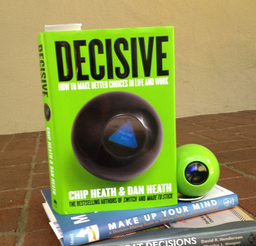You may remember my friend Don from this The Power of Habit review post. If not, I will refresh your memory. Don is an avid reader of all things non-fiction – especially on business topics like motivation and organizational behavior. We have a bunch of books we have discussed and a mini-book club that we hold over G-chat! For some additional background, Don is also an avid runner (he paced me in the Allstate 13.1 earlier this year), an engineer by training, a recent MBA grad, a good friend and a real creature of habit! Here is his next review. I love how he incorporates the Seinfeld examples to cement the concepts. I think you will, too. Here’s Don!
Decisive: How to Make Better Choices in Life and Work is an entertaining and informative book about the mistakes people, and organizations, make when trying to solve problems. It provides a robust framework which can be used to make better decisions going forward. The Heath brothers identify four villains that can negatively impact decision making:
1. Narrow framing
We tend to use information that is immediately available to us, which limits our ability to see other options to choose from. Teenagers see decisions as “Whether Or Not” 30% of the time. For example, “Should I go to the party or not”? That only gives the teenager 2 options: Have fun going out or be the loser who stays home. So in reality, there’s only one option. Teenagers making bad decisions isn’t exactly an earth shattering revelation. What is more surprising is that most organizations make decisions in that way with similar frequency.
2. Confirmation bias
Even when we get out of the narrow frame and realize that we need more information to make a decision, we typically look for information that proves our initial gut reaction. A good example of this is a list of “Pros and Cons.” Frequently, the data found is self-serving and used to prove we were right along. The problem is this ‘data’ doesn’t help us make a better, more informed decision.
3. Short-term emotion
Does this need much explanation? I think not. In the heat of the moment we make impulsive decisions without considering the long-term consequences. Even if we know there are long term ramifications, we don’t care because we want something NOW!!
4. Overconfidence
This is pretty obvious, too. We think we are going to be right much more often than we actually are. Furthermore, we think we know exactly how things will end up and neglect to account for a range of possibilities that could occur.
In order to minimize the effect of the villains the Heath brothers developed WRAP. An easy acronym that stands for:
Widen Your Options
Reality Test Your Assumptions
Attain Distance Before Deciding
Prepare to be Wrong
Rather than highlighting some of the tools given to apply this process (and risk omitting something you might find helpful), I think it would be useful and entertaining to dissect a dilemma from my favorite TV show, Seinfeld. The decision is described below when Jerry and Elaine discuss whether to take their currently platonic relationship to a physical level:
I’ll give Jerry and Elaine a little credit. They didn’t jump on each other impulsively like a couple of hormone charged, drunken college kids. They recognized it was a significant decision with risk of negative long-term consequences. However, in general their decision making could improve using the WRAP process.
Widen Your Options:
Jerry and Elaine fell into a classic ‘Whether or Not’ decision. There were only two options: Carry on an extended Friends-With-Benefits relationship for an indefinite period time (or not). Maybe they could have agreed to get it on one more time that night and be done with. Ironically, this did happen in a future episode where they had “sex to save the friendship.”
Reality Test Your Assumptions
The couple came up with a system of rules to avoid relationship pitfalls, but these rules were really a farce. As evidenced by George’s reaction to Jerry’s explanation the following day at the coffee shop.
It was inevitable the rules would fail and the friendship of “This, That, and The Other” would be jeapordized.
Attain Distance Before Deciding
Here is where the decision really failed. They made their decision quickly in an aroused state while watching the “naked station.” They would have been better served to sleep on problem (alone) and delay the decision until they were more calm.
Prepare to be Wrong
Jerry and Elaine anticipated potential problems, but that knowledge did not help them avoid these problems at all. They should have asked themselves “What is the worst thing that could happen?” before taking the plunge and realizing theirdecision could result in “No This OR That”. Later in the episode George and Jerry do this exercise and realize Jerry could kill Elaine’s future husband in a fit a rage and get the death penalty. (As a side note, who knew George would provide such good decision making counsel?)
Loved this review and this definitely piqued my interest! How about you? Do you fall prey to these decision making villains?


